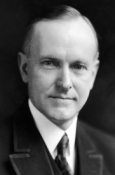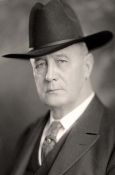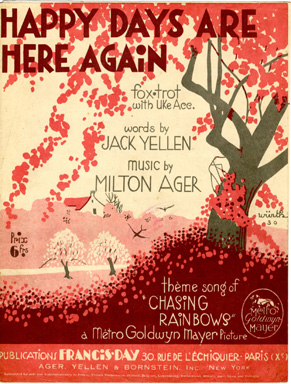
Postage Stamps of the United States - 1929
Politics

President
Jan. 1 - Mar. 3
Calvin Coolidge
Mar. 4 - Dec. 31
Herbert Hoover

Postmaster General
Jan. 1 - Mar. 4
Harry S. New
Mar. 5 - Dec. 31
Walter F. Brown
Music

Click Control Above To Hear
1929 "Happy Days Are Here Again
Postage Rates
Domestic Letter Rate: 2¢ per oz.
Postcard Rate: 1¢
Air Mail Rate: 5¢ per oz.
Stamps
The Commemorative Postage Stamps of 1929
Flat Plate - Perforated 11
400 Subject Plates except George Rogers Clark (100 Subject Plates)

George Rogers Clark
First day: Feb. 25, 1929
16,684,674 issued

Sullivan Expedition
June 17, 1929
51,451,880 issued

5¢ Civil Aeronautics
First Day: 12/12/28
10,319,700 issued

5¢ Civil Aeronautics
First Day: 12/12/28
10,319,700 issued
Colonel George Rogers Clark - Surrender at Sackville
The George Rogers Clark stamp was physically the largest commemorative issued by the U.S. to that date. Combined with the bi-colored design, the cost of producing this issue was entirely out of character for then Postmaster New. The reasons for this change of heart are not entirely clear, perhaps it was the fact that New's term as Postmaster General would be ending soon, or the fact that New was from Indiana, the site of the Battle of Vincennes commemorated by this stamp.
The unwieldy size of this stamp made it somewhat impractical for use as postage, especially since it was only a 2¢ stamp, and many of the stamps issued were never used postally. Still the stamp set a record for a single day's sales from one post office, more than 300,000 stamps were sold on the first day in Vincennes, Indiana, the only city in which First Day sales were made. The bi-colored design made for a wide variety of plate positions, in fact so many plate blocks were saved by collectors that the plate block can be had today for much less than any of its contemporaries.
Major General John Sullivan Expedition
The Sullivan stamp commemorated the total devastation of the Iroquois lands in New York and Pennsylvania, necessitated by the Iroquois Nations allegiance to the British during the Revolutionary War. This devastation is hardly something that would be considered worthy of commemoration today, but in 1929 sentiment was different. Crippling the Iroquois Nations was a necessary evil in that it severely weakened Britain's presence in western New York and northeastern Pennsylvania. Sullivan's place in history has been somewhat obscured, perhaps by the brutality of his army's acts and certainly by his unpleasant and unpopular disposition.
The issuance of this stamp met with the usual resistance from Postmaster New, who did everything in his power to prevent new issues. The stamp was finally authorized after much political pressure was placed on the new Postmaster General Brown, who continued New's attitude that new issues were a costly nuisance. My, how times have changed!
First Day sales were politically charged also. It is strange that with much of the pressure put on Brown coming from Pennsylvania politicians, all of the cities chosen for First Day sales were in New York. Here is a list of the cities: Auburn, Binghamton, Canajoharie, Canandaiga, Elmira, Geneseo, Geneva, Horseheads, Owego, Penn Yan, Perry, Seneca Falls, Waterloo, Watkins Glen and Waverly. At the time, this was by far and away the most First Day cities for a new issue.
The Battle of Fallen Timbers Commemorative
The "Battle of Fallen Timbers" stamp is another in a long line of issues during this period that leaves one scratching their head. With all of the important events of the Revolution reaching their sesquicentennial anniversaries, it is amazing that stamps such as this and the subsequent "Ohio River Canalization" stamps were issued in their stead.
Amazing that is, unless one considers political motivations. The position of Postmaster General had long been considered a political plum, since the Postmaster had the authority to appoint the Postmaster position in cities around the country. Apparently this latitude was used when decisions to issue new stamp designs were made. It can hardly be a coincidence that after refusing to issue stamps commemorating important events of the Revolutionary War, two relatively obscure events from Ohio were honored by a Postmaster from, you guessed it, Ohio.
To make matters worse, the "Battle of Fallen Timbers" celebrated the 135th anniversary and the "Ohio River Canalization" the 54th anniversary of the event they commemorated. This must have been quite a slap in the face to the petitioners that had been declined the issuance of stamps commemorating important 150th anniversaries associated with the birth of our nation and most likely explains the poor reception these stamps received from the press.
The "Battle of Fallen Timbers", although perhaps not well known outside of Ohio, did shape the American landscape. At the time, Ohio was part of the western frontier of the recently formed United States. The early settlers were understandably having problems with Native Americans thwarting U.S. presence in the region. Britain and France had already established settlements and the U.S. did not want to lose the territory to foreign powers. Offers of a peaceful settlement drew no response, and U.S. troops decided the issue forcibly, with the decisive battle near Toledo in a wooded area in which a tornado had blown over most of the trees (hence the name "Fallen Timbers").
First Day Sales were at Maumee, Perrysburg, Toledo and Waterville, Ohio and also at Erie, Pennsylvania, the final resting place of General Wayne, the commander of the troops at "Fallen Timbers".
The Ohio River Canalization Tribute
The Ohio river is formed by the junction of the Monongahela and Allegheny rivers in Pittsburgh. It runs more than 967 miles from Pittsburgh to Cairo, Illinois where it empties into the Mississippi river and is joined along the way by a number of important rivers. Untamed, seasonal fluctuations in water depth made these important routes of commerce unnavigable. In 1875 work began on the canalization of the Ohio River, utilizing a system of dams and locks guaranteeing a nine foot channel from Pittsburgh, Pa. to Cairo, Ill. In 1929 the Corps of Engineers completed the project transforming the Ohio, Monongahela and Allegheny rivers into a navigable stair-stepped chain of lakes.
First Day sales were in seven cities, representing six states along this major trade route: Pittsburgh and Homestead, Pennsylvania; Wheeling, West Virginia; Cincinnati, Ohio; Louisville, Kentucky; Evansville, Indiana; and Cairo, Illinois.
Today the issue of the above two "Ohio" stamps would barely raise an eyebrow, and perhaps hold more merit than stamps honoring the likes of Bugs Bunny and Daffy Duck, but at the time the resentment was loud and clear. This resentment was tempered somewhat, for only ten days after the Ohio River Canalization stamps had been issued, on October 29, 1929, immortalized as "Black Tuesday", America and the world entered the Great Depression.
The Electric Light's Golden Jubilee - "Edison Light Bulb" Commemoratives of 1929

Flat Plate - Perf 11
400 Subject Plates
31,679,200 issued
First Day: June 5, 1929

Rotary - Perf 11 x 10½
400 Subject Plates
210,119,474 issued
First Day: June 11, 1929

Rotary Coil - Perf 10 Vert.
170 Subject Plates
133,530,000 issued
First Day: June 11, 1929
On October 21, 1879, Thomas Edison and his associates applied current to a carbonized cotton filament light bulb under vacuum. The filament glowed a soft orange until it finally burnt out 13 hours later. And the rest is history, as they say.
The "Electric Light's Golden Jubilee" or "Edison Light Bulb" stamps, as they are more commonly called, were issued to commemorate this event. They were issued on June 5, rather than October 21, to promote the National Electric Light Association Convention in Atlantic City. Edison's name appears on the stamps, but a likeness was forbidden, law prohibited placing a living person's face on a U.S. postage stamp.
Like the Harding Memorial stamp, this stamp was issued in three formats, although rather than imperforate, it was issued in sidewise coils. The coils were produced for the utility companies who wanted to use the stamp for promotional purposes on outgoing mail. The demand was so great that the initial orders of 75,000,00 each for the rotary stamps proved insufficient and second printings were needed for both.
The perf 11 flat plate stamp set new records for First Day sales, 800,000 stamps were sold on June 5 in Edison's home town of Menlo Park, New Jersey, the only city in which First Day sales were made. This number includes back orders, since the initial supply of 400,000 was quickly exhausted. Surprisingly, no First Day sales were made at either the Philatelic Agency in Washington, D.C. or at the National Electric Light Association Convention in Atlantic City, for which the stamp had implicitly been designed.
The following postage stamp varieties were first issued by the U.S. in 1929
No new varieties of U.S. Air Mail stamps were issued in 1929
No new varieties of U.S. Special Delivery stamps were issued in 1929
No new varieties of U.S. Special Handling stamps were issued in 1929
No new varieties of U.S. Postage Due stamps were issued in 1929
Ordinary issue
Number 599A - 2¢ Type II Washington rotary coil perf 10 vert. - EKU: 3/29/1929
Number 653 - ½¢ Nathan Hale rotary perf 11 x 10½ - First Day: 5/25/1929
Number 658 - 1¢ Franklin Kansas Overprint - First Day: 5/1/1929
Number 659 - 1½¢ Harding Kansas Overprint - First Day: 5/1/1929
Number 660 - 2¢ Washington Kansas Overprint - First Day: 5/1/1929
Number 661 - 3¢ Lincoln Kansas Overprint - First Day: 5/1/1929
Number 662 - 4¢ Martha Washington Kansas Overprint - First Day: 5/1/1929
Number 663 - 5¢ Theodore Roosevelt Kansas Overprint - First Day: 5/1/1929
Number 664 - 6¢ Garfield Kansas Overprint - First Day: 5/1/1929
Number 665 - 7¢ McKinley Kansas Overprint - First Day: 5/1/1929
Number 666 - 8¢ Grant Kansas Overprint - First Day: 5/1/1929
Number 667 - 9¢ Jefferson Kansas Overprint - First Day: 5/1/1929
Number 668 - 10¢ Monroe Kansas Overprint - First Day: 5/1/1929
Number 669 - 1¢ Franklin Nebraska Overprint - First Day: 5/1/1929
Number 670 - 1½¢ Harding Nebraska Overprint - First Day: 5/1/1929
Number 671 - 2¢ Washington Nebraska Overprint - First Day:5/1/1929
Number 672 - 3¢ Lincoln Nebraska Overprint - First Day: 5/1/1929
Number 673 - 4¢ Martha Washington Nebraska Overprint - First Day: 5/1/1929
Number 674 - 5¢ Theodore Roosevelt Nebraska Overprint - First Day: 5/1/1929
Number 675 - 6¢ Garfield Nebraska Overprint - First Day: 5/1/1929
Number 676 - 7¢ McKinley Nebraska Overprint - First Day: 5/1/1929
Number 677 - 8¢ Grant Nebraska Overprint - First Day: 5/1/1929
Number 678 - 9¢ Jefferson Nebraska Overprint - First Day: 5/1/1929
Number 679 - 10¢ Monroe Nebraska Overprint - First Day: 5/1/1929
Commemoratives
Flat Plate - Perf 11 x 11 unless otherwise noted
Number 651 - 2¢ George Rogers Clark
Designer: C. A. Huston - Engravers: L. Schofield (vignette) - E. M. Hall (lettering)
Number 654 - 2¢ Electric Light's Golden Jubilee
Designer: A. R. Meissner - Engravers: J. C. Benzing (vignette) - E. M. Hall (lettering)
Number 655 - 2¢ Electric Light's Golden Jubilee - Edison's Lamp - rotary perf 11 x 10½
Number 656 - 2¢ Electric Light's Golden Jubilee - Edison's Lamp - rotary coil perf 10 vertically
Number 657 - 2¢ Sullivan Expedition
Designer: C. A. Huston - Engravers: J. Eissler ( (vignette) - E. M. Hall & E. H. Helmuth (lettering)
Number 680 - 2¢ Battle of Fallen Timbers
Designer: C. A. Huston - Engravers: L. Schofield (vignette) - E. M. Hall (lettering) - E. H. Helmuth (numerals)
Number 681 - 2¢ Ohio River Canalization
Designer: A. R. Meissner - Engravers: Frederick Pauling (vignette) - E. M. Hall (lettering)





